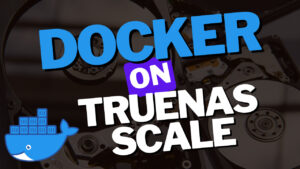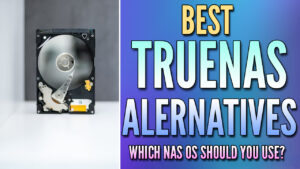In this article, we’re going to look at OpenMediaVault vs. TrueNAS.
OpenMediaVault and TrueNAS are extremely similar, but also very different. They’re similar in the sense that they’re both NAS operating systems that allow you to set up different shared folders and access them from other devices.
However, where they differ greatly is in the filesystem that they use, the user interface, and the overall system requirements. You might prefer one over the other depending on what your goals are, but we’re going to take a look at the exact differences below.
OpenMediaVault vs. TrueNAS
Before we look at OpenMediaVault vs. TrueNAS, we’re going to look at the background of both of these operating systems.
What is OpenMediaVault? – OpenMediaVault vs. TrueNAS
OpenMediaVault is an open-source network-attached storage (NAS) operating system based on Debian Linux. OpenMediaVault has all of the features you’d expect from a NAS operating system, but my favorite feature of OpenMediaVault is how user-friendly it is and its compatibility with different types of hardware. Due to how easy it is to use OpenMediaVault, it’s a great NAS operating system to learn on.
To expand on OpenMediaVault’s compatibility, it can be installed on bare metal, as a virtual machine, or even on a Raspberry Pi (which means that you can technically turn a Raspberry Pi into a NAS). It’s also extremely resource friendly. Overall, that hits the majority of systems out there and makes OpenMediaVault a consideration for most people as their hardware will almost certainly work with the OS.
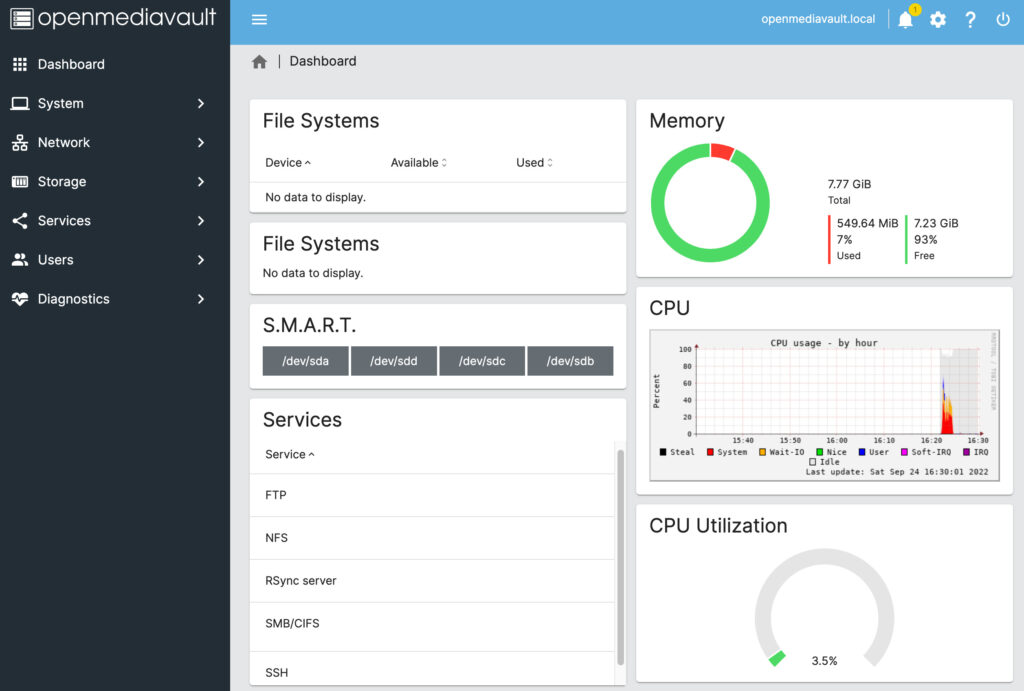
What is TrueNAS? – OpenMediaVault vs. TrueNAS
TrueNAS is an operating system developed on the OpenZFS file system. TrueNAS is different in the fact that there are two different versions: TrueNAS Core and TrueNAS Scale. TrueNAS Core was created in 2005 (formerly known as FreeNAS) and is built on FreeBSD. TrueNAS Scale was created in 2022 and is built on Debian Linux.
They both have similarities and differences, so I urge you to read about their differences if you decide to use TrueNAS as you’ll be able to make an informed decision on which version is best for you. Regardless of the version that you use (TrueNAS Core or Scale), TrueNAS is free and open-source.
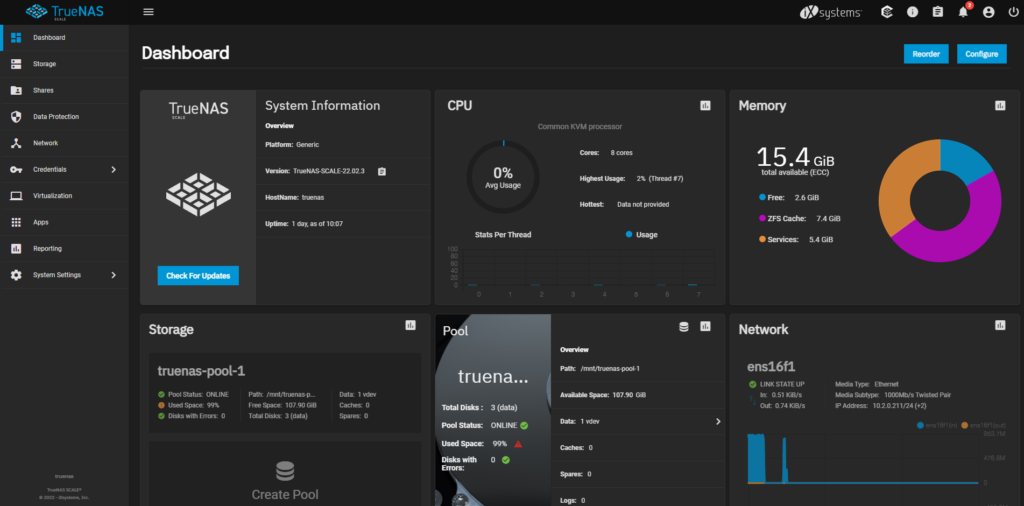
File Systems: OpenMediaVault vs. TrueNAS
The first, and the biggest difference between OpenMediaVault and TrueNAS is the file systems that they use. OpenMediaVault gives users the ability to set up a volume as various different types of filesystems, with the main being Ext4, XFS, and BTRFS. OpenMediaVault technically supports ZFS, but you must install a plugin, where TrueNAS supports ZFS natively.

All of the filesystems that can be set up on OpenMediaVault are extremely different and the one question you’ll need to answer is if you want to use ZFS. If you do and you want native ZFS support (meaning that you don’t need additional plugins), you won’t be able to use OpenMediaVault and will be forced to use TrueNAS.
However, you must keep in mind that the device you’re using must support TrueNAS. As an example, if you’d like to install a NAS operating system on a Raspberry Pi, TrueNAS isn’t an option. There are also somewhat strict hardware requirements which we’ll take a look at below.
OpenMediaVault File System
After you create your RAID array in OpenMediaVault, you will be able to create a file system. The biggest downside of OpenMediaVault (at least at this point in time) is that many of the benefits of BTRFS (data scrubbing, for example) must be completed through the CLI. If you’re using BTRFS, you want to ensure that you configure data scrubbing, so OpenMediaVault’s ease of use falls a little short in this category.
I also shy away from using ZFS on OpenMediaVault, but that’s not to say that it doesn’t work. You can install OMV-Extras to get it working, but generally, I’d just rather use TrueNAS if ZFS is a requirement.

TrueNAS File System
ZFS is natively supported in TrueNAS. When you set up a storage pool in TrueNAS, most people will use RAIDZ1 or RAIDZ2. RAIDZ1 allows one hard drive to fail without data loss (similar to RAID 5), and RAIDZ2 allows two hard drives to fail without data loss (similar to RAID 6).
There are so many benefits of ZFS that I can’t list them all here, but I’d definitely suggest you check out this article to learn about some of them.

Data Management: OpenMediaVault vs. TrueNAS
OpenMediaVault and TrueNAS are very similar when it comes to adding and removing data from your NAS. With both operating systems, you’ll create shared folders that can be accessed through your network (SMB, NFS, etc). This is the most important function of any NAS, and while the setup process is different depending on the operating system that you’ll be using, the functionality and end-user experience will be similar.
Where these operating systems start to differ is with data protection. ZFS is extremely powerful, and since it’s natively supported in TrueNAS, setting up snapshots and scrub tasks is nothing more than a few clicks. Since I always try and use BTRFS or ZFS with any NAS device that I buy or build, having the scrub/snapshots built into the GUI is great, and I strongly prefer TrueNAS in this regard.

Applications: OpenMediaVault vs. TrueNAS
OpenMediaVault and TrueNAS both offer tons of great applications, though TrueNAS offers a bunch of these applications as soon as the system is installed.
For OpenMediaVault, it’s in your best interest to install OMV-Extras as it will give you a bunch of different plugins to install, as well as the ability to install Docker and Portainer/Yacht (to manage Docker and install apps like NextCloud). Without OMV-Extras installed, you’ll have an extremely limited number of plugins that you can install through the GUI. Fortunately, OMV-Extras is very easy to set up and use. However, if you really don’t want to install OMV-Extras, OpenMediaVault is fairly barebones.

TrueNAS is very different than OpenMediaVault as the applications that you can install are available by default and there are tons of them. However, there is a difference in exactly what you can install depending on if you’re using TrueNAS Core or TrueNAS Scale.
With TrueNAS Scale, you’ll have a bunch of different applications you can install directly in the apps section.
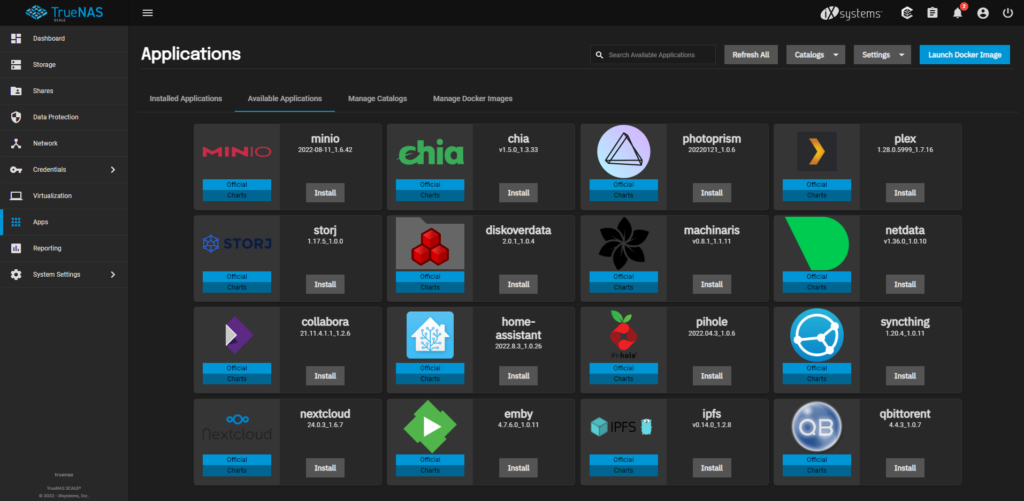
TrueNAS Core allows you to create plugins that are installed in jails, meaning that the service is technically isolated from the operating system.

The overall takeaway is that TrueNAS Scale and TrueNAS Core allow you to install applications, but the process and architecture behind them will be slightly different.
Compatibility & Requirements: OpenMediaVault vs. TrueNAS
From a pure compatibility standpoint, OpenMediaVault and TrueNAS will run on various different types of hardware. This means that if you have old hardware laying around or you’d like to build a new server, there’s a good chance that you can get OpenMediaVault or TrueNAS working. However, OpenMediaVault offers a layer of compatibility that TrueNAS doesn’t, and that’s with various types of hardware. For example, OpenMediaVault is fully functional on Raspberry Pi hardware – something that TrueNAS doesn’t support.
One other distinction is that ZFS is extremely memory hungry, and while OpenMediaVault gives you the option of using ZFS, it’s mandatory with TrueNAS. The minimum amount of memory you’re able to use with TrueNAS is 8GB, though most suggest a minimum of 16GB. On the other hand, OpenMediaVault will run perfectly fine on devices with as little as 1GB of memory.
This is a huge difference, as if your hardware is older or not particularly powerful, OpenMediaVault will probably run it, while TrueNAS won’t.

Another highly debated discussion is the use of ECC memory with ZFS. Without diving too far into this, ECC memory detects and corrects memory errors, while non-ECC memory doesn’t. This is a huge benefit, as ECC memory shouldn’t write any errors to the disk. Many feel that this is a requirement for ZFS, and thus feel like ECC memory is a requirement for TrueNAS. I’m pointing this out because hardware options are minimal for ECC memory – at least when compared to non-ECC memory.
The counterpoint to this is argument is that ECC memory helps all filesystems. The question you’ll need to answer is if you want to run ECC memory with TrueNAS because if you do, you’ll need to ensure that your hardware supports it.
On a personal level, I don’t run TrueNAS without ECC memory, but that’s not to say that you must. This is a huge difference between OpenMediaVault and TrueNAS and you must consider it when comparing these NAS operating systems.
Conclusion: OpenMediaVault vs. TrueNAS
This article looked at OpenMediaVault vs. TrueNAS. Overall, both of these are truly great NAS operating systems. If you have a device with lower system resources, OpenMediaVault is quite possibly the best NAS operating system you can run. However, if you have a fully decked-out home server with ECC memory, it’s hard to pass up on the native ZFS support that TrueNAS offers.
From a functionality perspective, it’s also nice that TrueNAS offers two different versions as you can pick whichever one works best for you (TrueNAS Core or TrueNAS Scale). While they are similar, there are certain differences that are important to think through before selecting which OS will work best for you. If you do intend on using TrueNAS, I highly suggest you read about the differences between TrueNAS Core and TrueNAS Scale.
Thanks for checking out the article on OpenMediaVault vs. TrueNAS. If you have any questions on OpenMediaVault vs. TrueNAS, please leave them in the comments!


